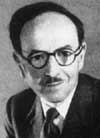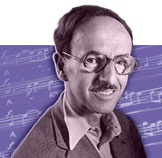 |
 Born
in Budapest, Hungary, in 1905, Matyas Seiber studied the cello at the
Royal Academy in his home city. He also studied composition with the
famous Hungarian composer Zoltan Kodaly. After graduation, Seiber became
a Professor at Frankurt Conservatory in Germany, teaching harmony and
composition. However, after a couple of years, he gave up his position
in favour of travelling around Europe, then taking a job as a musician
in an ocean liner's resident orchestra. In seeing the world, Seiber
developed a keen interest in international folk music, jazz and blues
- key features in his later compositions. Born
in Budapest, Hungary, in 1905, Matyas Seiber studied the cello at the
Royal Academy in his home city. He also studied composition with the
famous Hungarian composer Zoltan Kodaly. After graduation, Seiber became
a Professor at Frankurt Conservatory in Germany, teaching harmony and
composition. However, after a couple of years, he gave up his position
in favour of travelling around Europe, then taking a job as a musician
in an ocean liner's resident orchestra. In seeing the world, Seiber
developed a keen interest in international folk music, jazz and blues
- key features in his later compositions.In 1929, Seiber returned to the Frankfurt Conservatory where he set up a School of Jazz, one of the first attempts anywhere to teach/study jazz as a serious musical subject. The rise of Hitler to power in 1933 put a premature end to jazz in Germany, the Nazi Party frowning upon a form of music emanating from an alleged inferior race i.e. the Negro. By 1936, to escape the Nazi persecution of Jews, Seiber relocated to London, England where he became a part of the classical musical establishment. Seiber taught composition at Morley College, where, in 2005, an exhibition of his life and works has been held.  In
London, he met up with some of Britain's best jazz and dance band musicians,
and also became very interested in the possibilities of the accordion
as an instrument for playing classical works. Seiber joined the teaching
staff of the newly founded British College of Accordionists, and soon
was writing music for the instrument - usually under the pen name G.
S. Mathis. In
London, he met up with some of Britain's best jazz and dance band musicians,
and also became very interested in the possibilities of the accordion
as an instrument for playing classical works. Seiber joined the teaching
staff of the newly founded British College of Accordionists, and soon
was writing music for the instrument - usually under the pen name G.
S. Mathis. Matyas Seiber was an erudite composer whose classical compositions were held in high regard by his peers in the classical world. His many works for the accordion included the tangos Gipsy Serenade and La Morenita, the waltz Sunlight and Shadow, the orchestral pieces Spring and Prelude and Fugue in the style of Buxtehude. He also composed the Advanced Solo test piece Galop Chromatique for the NAO 'Accordion Day' of 1949, and Magyar Rhapsody - the 1950 Advanced Band test piece. In 1938, as G. S. Mathis, he wrote the monumental ten-volume Mathis Method for Accordion - an accordion tutor that was in print until the 1970s.  Matyas
Seiber was one of the few musicians closely connected with the accordion
who also won equal, if not greater acclaim, in other forms of music.
He was, for example, regularly employed by the British film industry
as a composer of theme and incidental music, and similarly by the BBC
for radio plays. He was known, too, in the jazz world, and collaborated
with Johnny Dankworth in 1959 to produce Improvisation for Jazz Band
and Symphony Orchestra. Married with one daughter, Matyas Seiber was
killed in a car crash during a visit to South Africa in 1960. Matyas
Seiber was one of the few musicians closely connected with the accordion
who also won equal, if not greater acclaim, in other forms of music.
He was, for example, regularly employed by the British film industry
as a composer of theme and incidental music, and similarly by the BBC
for radio plays. He was known, too, in the jazz world, and collaborated
with Johnny Dankworth in 1959 to produce Improvisation for Jazz Band
and Symphony Orchestra. Married with one daughter, Matyas Seiber was
killed in a car crash during a visit to South Africa in 1960. The following year, M. Hohner published his last work, Irish Suite, for accordion orchestra. To this day, Irish Suite is a popular choice for accordion orchestras at the national UK Championships. |
|
©
Copyright 2005 Accordions Worldwide. All rights reserved
|
